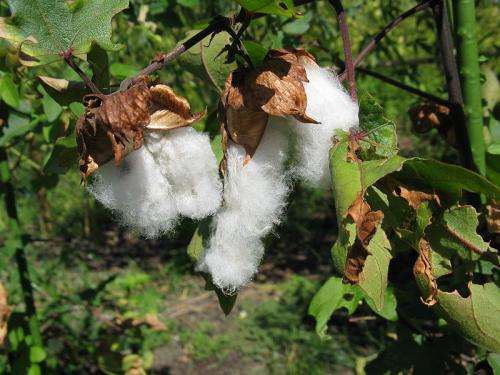Chinese scientists crack the genome of another diploid cotton Gossypium arboreum

Chinese scientists from Chinese Academy of Agricultural Sciences and BGI successfully deciphered the genome sequence of another diploid cotton— Gossypium arboreum (AA) after the completed sequencing of G. raimondii (DD) in 2012. G. arboreum, a cultivated cotton, is a putative contributor for the A subgenome of cotton. Its completed genome will play a vital contribution to the future molecular breeding and genetic improvement of cotton and its close relatives. The latest study today was published online in Nature Genetics.
As one of the most important economic crops in the world, cotton also serves as an excellent model system for studying polyploidization, cell elongation and cell wall biosynthesis. However, breeders and geneticists remain little knowledge on the genetic mechanisms underlying its complex allotetraploid nature of the cotton genome (AADD). It has been proposed that all diploid cotton species present may have evolved from a common ancestor, and all tetraploid cotton species came from interspecific hybridization between the cultivated species G. arboreum and the non-cultivated species G. raimondii.
After the completed sequencing of G. raimondii in 2012, researchers started the work on decoding the genome of G. arboreum. In this study, they sequenced and assembled the G. arboreum genome using whole-genome shotgun approach, yielding a draft cotton genome with the size of 1,694 Mb. About 90.4% of the G. arboretum assembled scaffolds were anchored and oriented on 13 pseudochromosomes.
Furthermore, researchers found the long terminal repeat (LTR) retrotransposons insertions and expansions of LTR families contributed significantly to forming the double-sized G. arboreum genome relative to that of G. raimondii. Further molecular phylogenetic analyses suggested that G. arboreum and G. raimondii diverged about 5 million years ago, and the protein-coding capacities of these two species remained largely unchanged.
To investigate the plant morphology mechanisms of cotton species, a series of comparative transcriptome studies were performed. Results suggested that NBS-encoding subfamilies played an essential role on the immune to Verticillium dahliae. The resistance of G. raimondii on Verticillium dahliae was caused by expansion and contraction in the numbers of NBS-encoding genes, accordingly the loss in the genome of G. arboreum was responsible to their susceptible.
Another interesting finding of this study is the cotton fiber cell growth, and they found the 1-aminocyclo-propane-1-carboxylic acid oxidase (ACO) gene was a key modulator. Researchers suggest the overproduction of ACO maybe the reason why G. raimondii have a poor production of spinnable fiber, while the inactivation of ACO in G. arboreum might benefit its fiber development.
The G. arboreum genome will be an essential reference for the assembly of tetraploid cotton genomes and for evolutionary studies of Gossypium species. It also provides an essential tool for the identification, isolation and manipulation of important cotton genes conferring agronomic traits for molecular breeding and genetic improvement.
More information: Genome sequence of the cultivated cotton Gossypium arboreum, DOI: 10.1038/ng.2987
Journal information: Nature Genetics
Provided by BGI Shenzhen
















